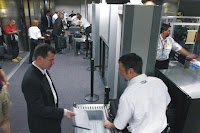The Office of the Inspector General at DHS recently released an unclassified summary of its undercover testing of airport screening, entitle an Audit of Airport Passenger and Checked Baggage Screening Performance. The OIG evidently sent in undercover agents to an undisclosed list of airports from May to August of last year. (you can read report here DHS OIG report)
The report doesn’t get in to the specifics of the experiment but you get a sense that if the IG presented TSA with six recommendations then there was probably something they could be doing better. TSA responded by thanking the OIG for it’s thoughtful oversight and replied that in April of 2007 they implemented
“the Aviation Screening Assessment Program to create a more systematic framework to assess the effectiveness of the screening process and provide statistically sound data. This program performed thousands of covert tests at airports nationwide in 2007. Under separate training programs, TSA conducts over a thousand covert tests for IED’s and almost 70,000 electronic image tests— every day.”
A lot of people are claiming this is primarily a people problem, that you must make screeners happier in their jobs and they will do a better job. If you take into account that 1.1 million people enter the US every day and there are rumours flying of a goal for screeners of 200 people/hour this is as clear a case as I have ever seen for an increased reliance on technology.
How could we expect any person to have the focus and the vigilance for 100% perfect screening while trying to cut down on queuing times? What we need is better technology that is less reliant on human manipulation. We wouldn’t use a calculator to manually fill in a spreadsheet, right?! We would use excel. So why do we rely so heavily on manual labour in airports? Because the technology just isn’t there yet.
Apparently in TSA agrees, and stated in the audit that in 2008 they will be introducing an improved screening checkpoint that focuses on three initiatives: “(1) improving hostile intent detection by reducing routine travel “noise” and focusing on telltale behavior; (2) deploying proven technology to screen for explosives on passengers and carry-on bags; and (3) reducing congestion and engaging passengers at more points in the journey—directly or indirectly.”
The report doesn’t get in to the specifics of the experiment but you get a sense that if the IG presented TSA with six recommendations then there was probably something they could be doing better. TSA responded by thanking the OIG for it’s thoughtful oversight and replied that in April of 2007 they implemented
“the Aviation Screening Assessment Program to create a more systematic framework to assess the effectiveness of the screening process and provide statistically sound data. This program performed thousands of covert tests at airports nationwide in 2007. Under separate training programs, TSA conducts over a thousand covert tests for IED’s and almost 70,000 electronic image tests— every day.”
A lot of people are claiming this is primarily a people problem, that you must make screeners happier in their jobs and they will do a better job. If you take into account that 1.1 million people enter the US every day and there are rumours flying of a goal for screeners of 200 people/hour this is as clear a case as I have ever seen for an increased reliance on technology.
How could we expect any person to have the focus and the vigilance for 100% perfect screening while trying to cut down on queuing times? What we need is better technology that is less reliant on human manipulation. We wouldn’t use a calculator to manually fill in a spreadsheet, right?! We would use excel. So why do we rely so heavily on manual labour in airports? Because the technology just isn’t there yet.
Apparently in TSA agrees, and stated in the audit that in 2008 they will be introducing an improved screening checkpoint that focuses on three initiatives: “(1) improving hostile intent detection by reducing routine travel “noise” and focusing on telltale behavior; (2) deploying proven technology to screen for explosives on passengers and carry-on bags; and (3) reducing congestion and engaging passengers at more points in the journey—directly or indirectly.”

No comments:
Post a Comment